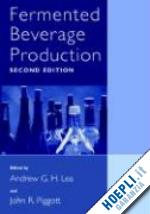1 Production of Fermentable Extracts from Cereals and Fruits.- MALTING.- REFERENCES.- 2 Alcoholic Beverage Fermentations.- YEAST.- PHYSIOLOGY OF YEAST GROWTH.- PRODUCTION OF FLAVOR COMPOUNDS.- REFERENCES.- 3 Beers: Recent Technological Innovations in Brewing.- THE TRADITIONAL BREWING PROCESS.- NEW TECHNOLOGICAL EVOLUTIONS.- NEW PRODUCTS: LOW ALCOHOL BEER, ALCOHOL-FREE BEER, AND ICE BEER.- CONCLUSION.- REFERENCES.- 4 Cidermaking.- HISTORY AND DEFINITION.- RAW MATERIALS.- FERMENTATION.- POST-FERMENTATION OPERATIONS.- CONCLUSION.- REFERENCES.- 5 White Wines.- WINE STYLES AND GRAPE VARIETIES.- IMPROVED PLANTING MATERIAL.- THE VINEYARD AND HARVEST.- PREFERMENTATION TREATMENTS.- YEAST AND FERMENTATION CONTROL.- POSTFERMENTATION OPERATIONS.- REFERENCES.- 6 Red Wines.- STYLES OF RED TABLE WINES.- GRAPE MATURITY AND HARVESTING.- PREFERMENTATION OPTIONS.- JUICE, SKIN AND SEED CONTACTING.- THE ETHANOL FERMENTATION.- MALO-LACTIC FERMENTATION.- POST-FERMENTATION HANDLING OF WINES.- PREPARATION FORBOTTLING.- REFERENCES.- 7 Sparkling Wines.- BASE WINES.- CARBONATION.- SECONDARY FERMENTATION BY YEAST.- YEAST LEES AGING.- METHOD OF CLARIFICATION.- THE FINAL PACKAGE.- SWEETENING.- AGING OF SPARKLING WINES IN THE ABSENCE OF YEAST-EFFECT OF HEAT AND LIGHT.- FOAM AND BUBBLES.- CONCLUSION.- REFERENCES.- 8 Fortified Wines: Sherry, Port and Madeira.- ALCOHOLIC FERMENTATION.- FORTIFICATION SPIRIT.- SHERRY.- PORT.- MADEIRA.- QUALITY ASPECTS.- ACKNOWLEDGEMENT.- REFERENCES.- 9 From Vine to Cognac.- THE GEOLOGY AND THE ’CRU’ (GROWTH AREA).- THE VINE VARIETIES.- THE WINEMAKING.- THE CHARENTE DISTILLATION.- THE AGING OF COGNAC.- BLENDING: AN IMPORTANT STEP IN THE PROCESS OF COGNAC PRODUCTION.- CONCLUSION.- REFERENCES.- 10 Armagnac and Wine-Spirits.- ARMAGNAC.- WINE-SPIRITS.- ETHYL CARBAMATE IN WINE SPIRITS.- CONCLUSION.- ACKNOWLEDGEMENTS.- REFERENCES.- 11 Whiskies.- MATERIALS.- MILLING, COOKING, AND MASHING.- FERMENTATION.- DISTILLATION.- MATURATION.- BLENDING.- FILTRATION.- RAW MATERIAL AND PRODUCT ANALYSES.- REFERENCES.- 12 Rum.- THE HISTORY OF RUM.- THE ORIGIN OF THE WORD ’RUM’.- CANE JUICE PRODUCTION.- MOLASSES.- MOLASSES HANDLING.- CANE JUICE.- DIFFERENT TYPES OF MOLASSES.- YEASTS.- YEAST PROPAGATION.- FERMENTATION.- FERMENTATION EFFICIENCIES.- DISTILLATION.- POT DISTILLED RUM.- HIGH ESTER RUMS.- COLUMN DISTILLATION.- INVENTORY CONTROL AND MANAGEMENT.- THE AGING OF RUM—MATURATION.- THE AROMA AND FLAVOR OF RUM.- EFFLUENT DISPOSAL.- QUALITY.- SUMMARY AND CONCLUSION.- REFERENCES.- 13 Vodka, Gin and Other Flavored Spirits.- DEFINITIONS AND REGULATIONS.- BRANDS, MARKETS AND VOLUMES.- VODKA, GIN AND FLAVORED SPIRIT PRODUCTION.- ANALYSIS.- ACKNOWLEDGEMENTS.- REFERENCES.- 14 Liqueurs & Speciality Products.- STATISTICS.- LEGAL DEFINITIONS.- COMPOSITION.- CREAM LIQUEURS.- COCKTAILS.- SUMMARY.- REFERENCES.- 15 Cachaça, Pisco and Tequila.- CACHAÇA: THE BRAZILIAN SUGAR CANE SPIRIT.- PISCO.- TEQUILA.- REFERENCES.- 16 Filtration and Stabilization of Beers.- BACKGROUND TO BEER STABILITY.- THE IMPORTANCE OF OXYGEN.- COLD CONDITIONING.- CONVENTIONAL POWDER FILTRATION.- STABILIZATION WITH PROCESSING AIDS.- DILUTION OF HIGH-GRAVITY BEERS.- PASTEURIZATION.- COLD STERILIZATION OF BEER.- GAS ADJUSTMENT.- CASK ALES.- BEER RECOVERY.- THE FUTURE.- ACKNOWLEDGEMENTS.- REFERENCES.- 17 Flavor Chemistry.- RAW MATERIALS.- FERMENTATION.- DISTILLATION.- CONTRIBUTION OF AGING TO FLAVOR.- CONCLUSION.- REFERENCES.












